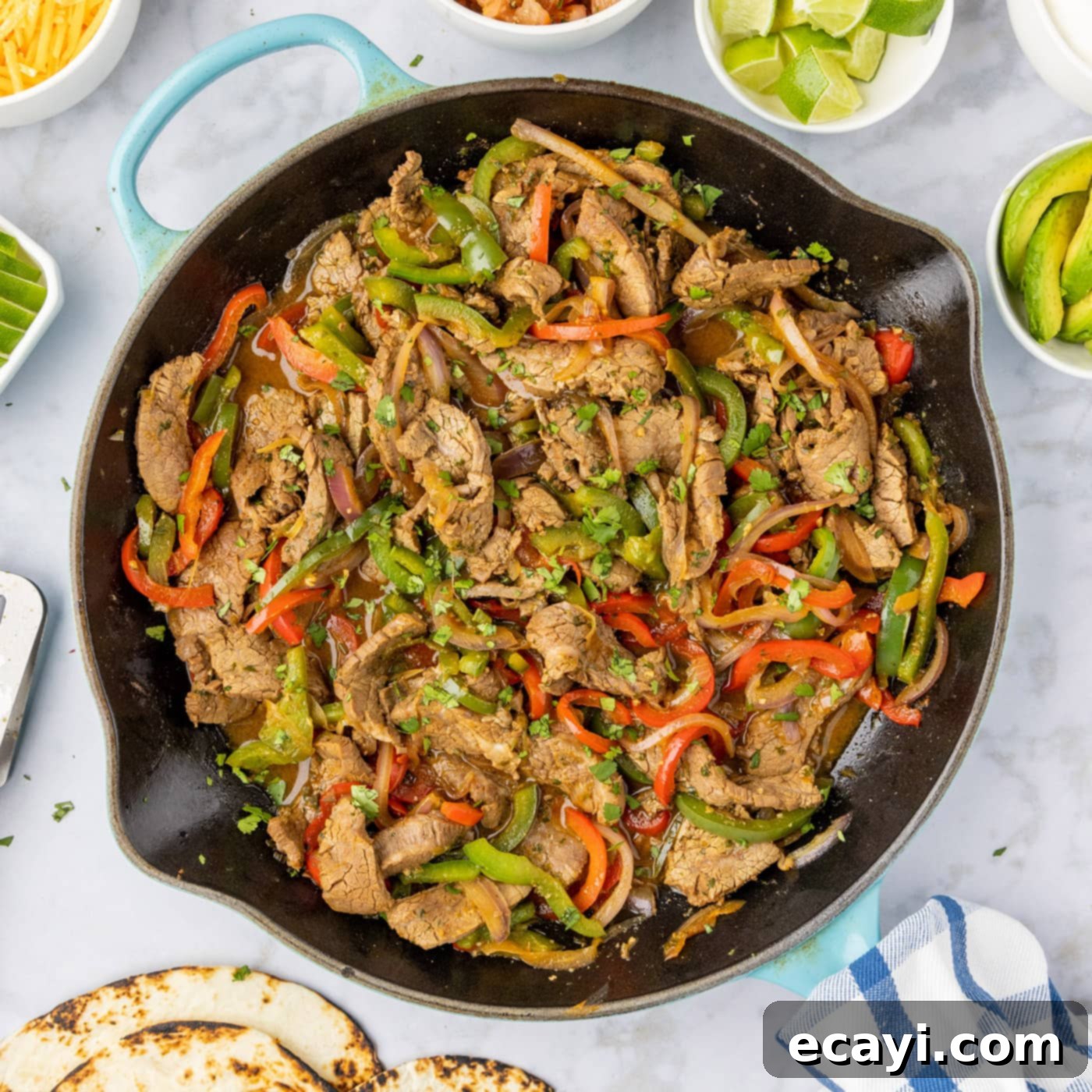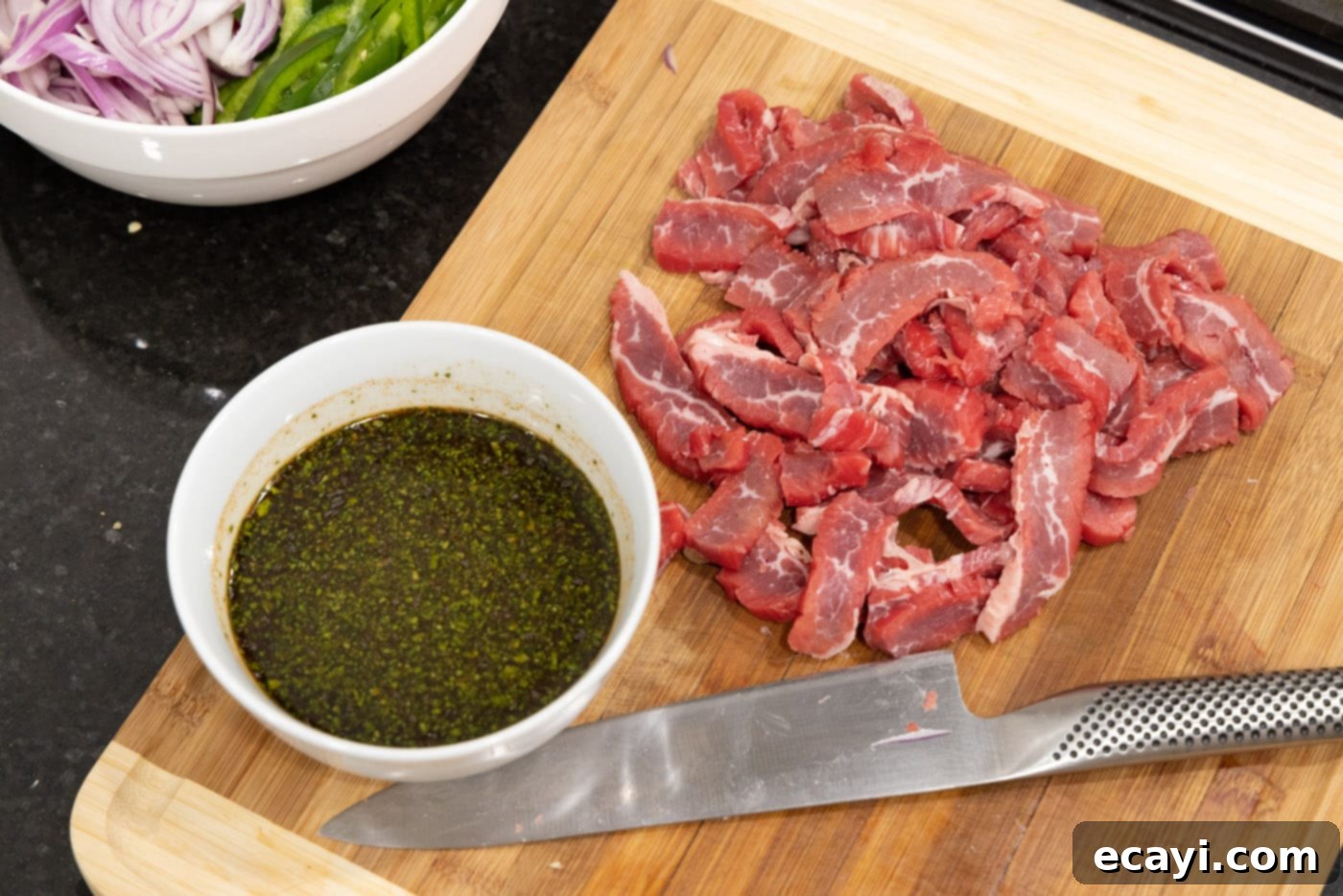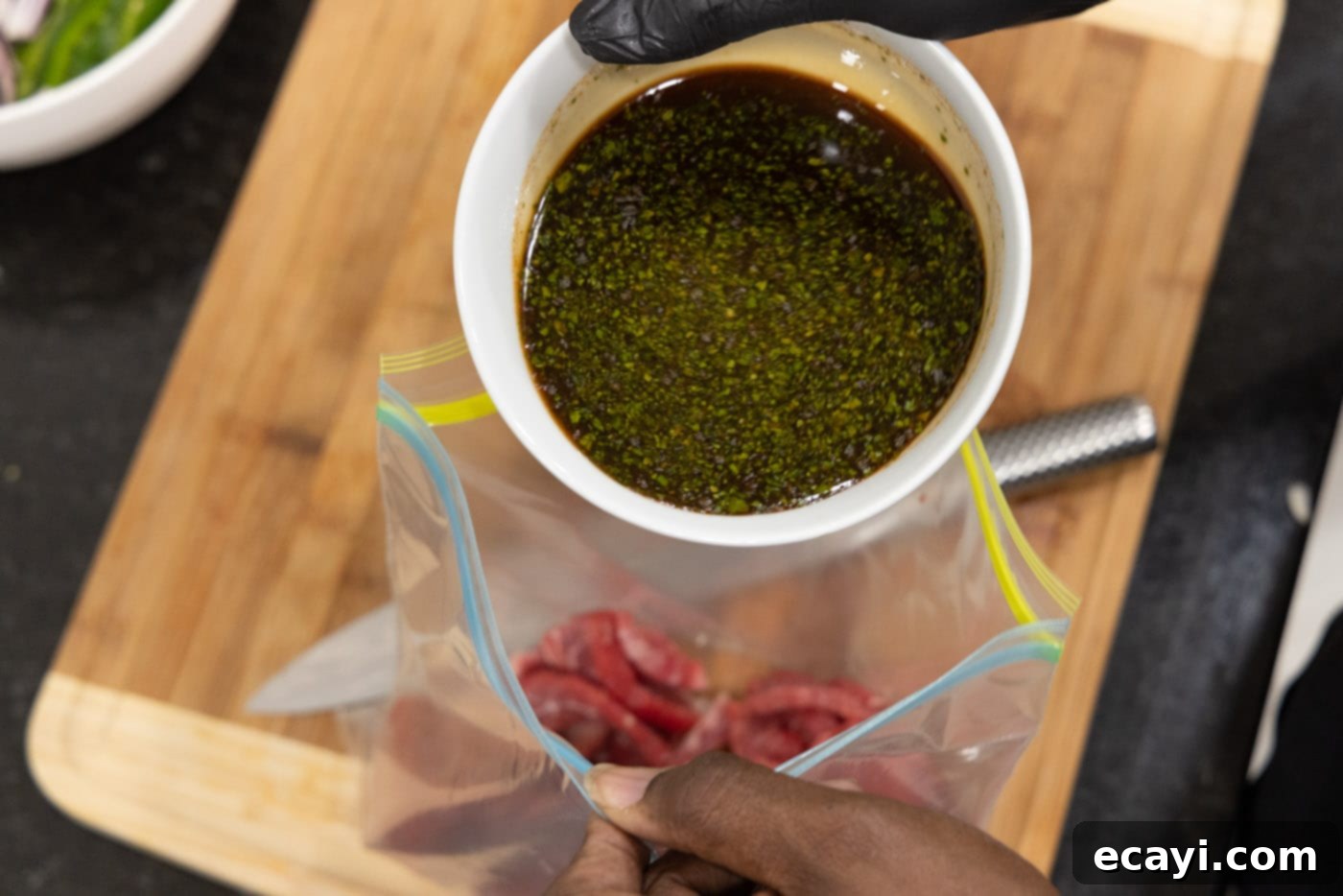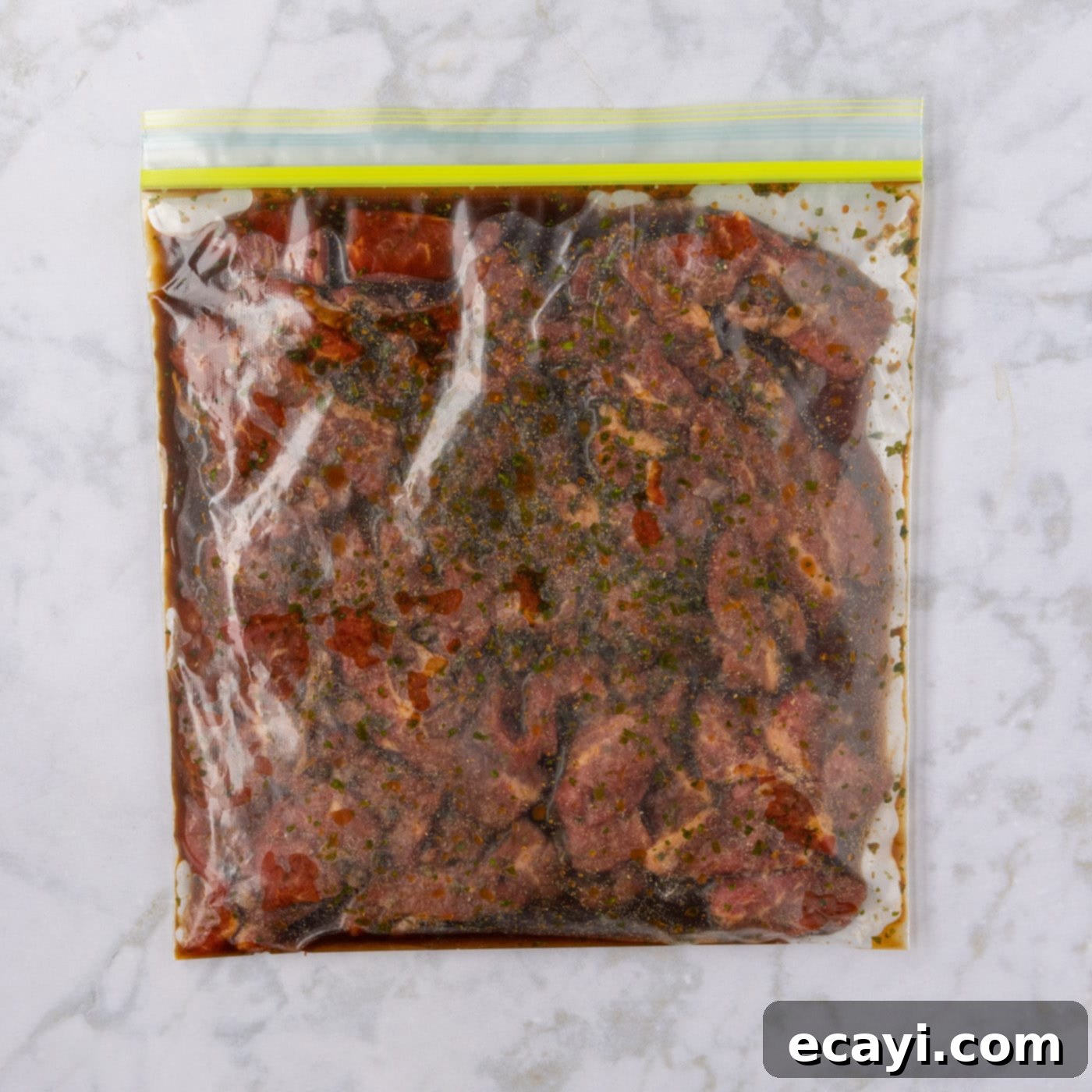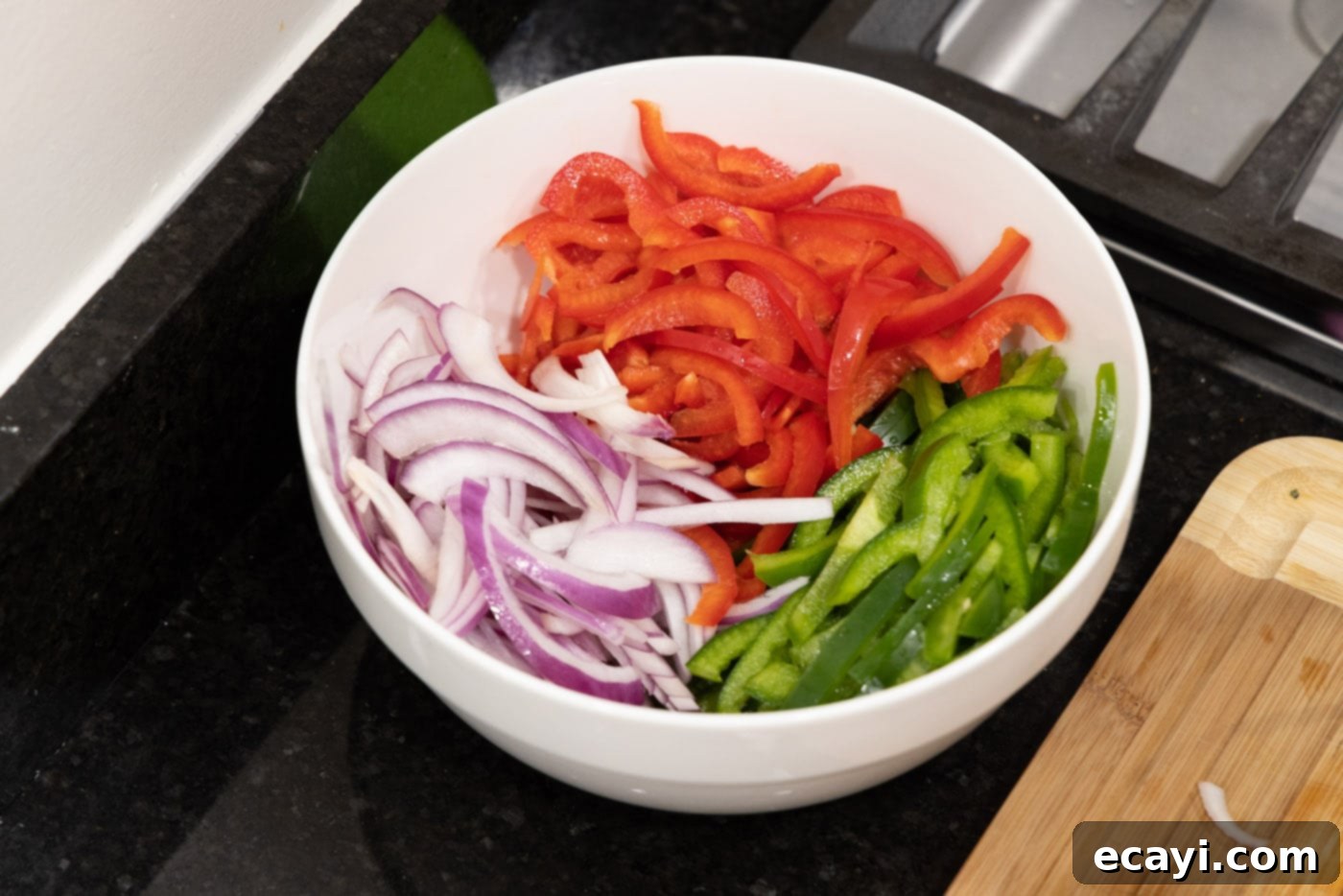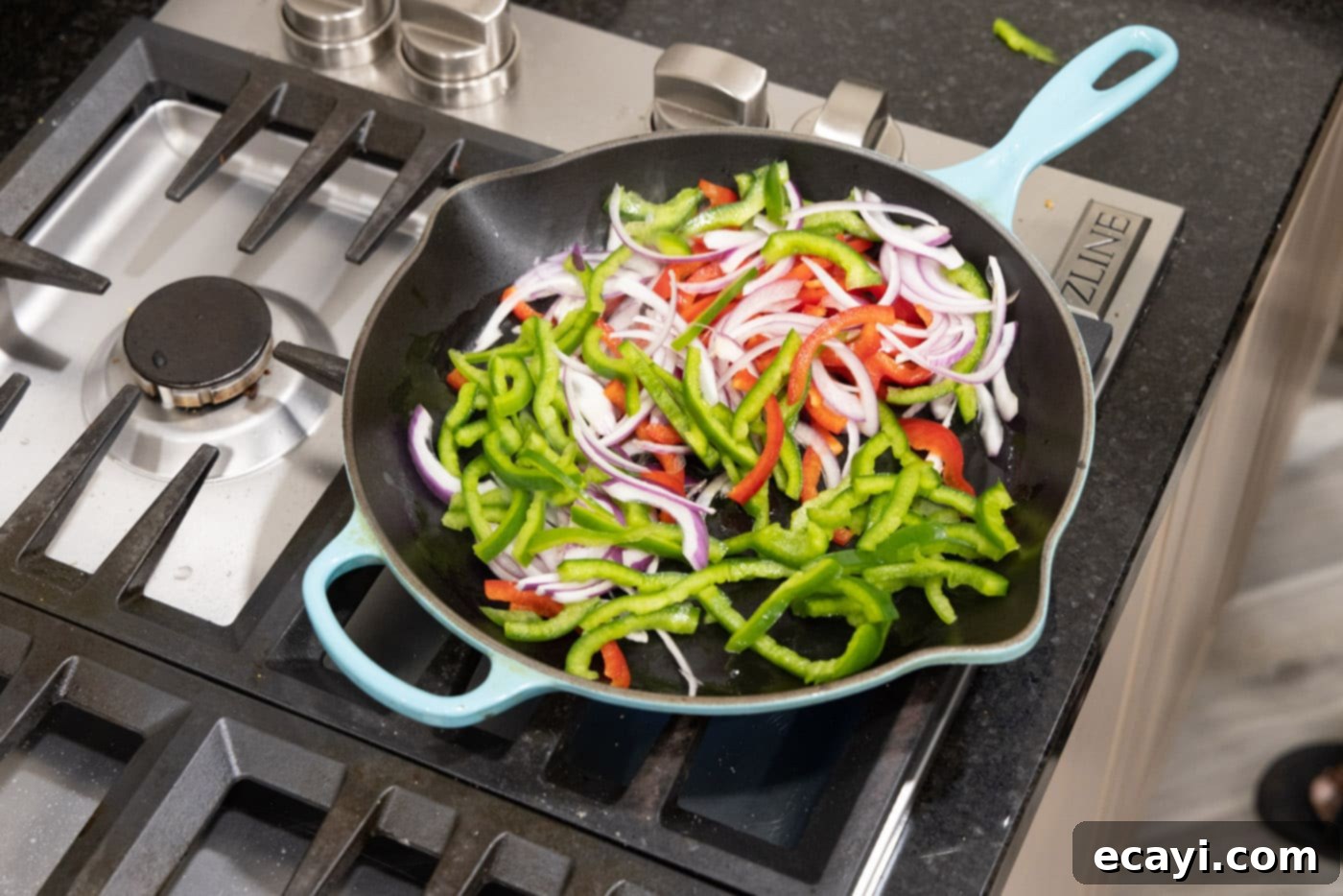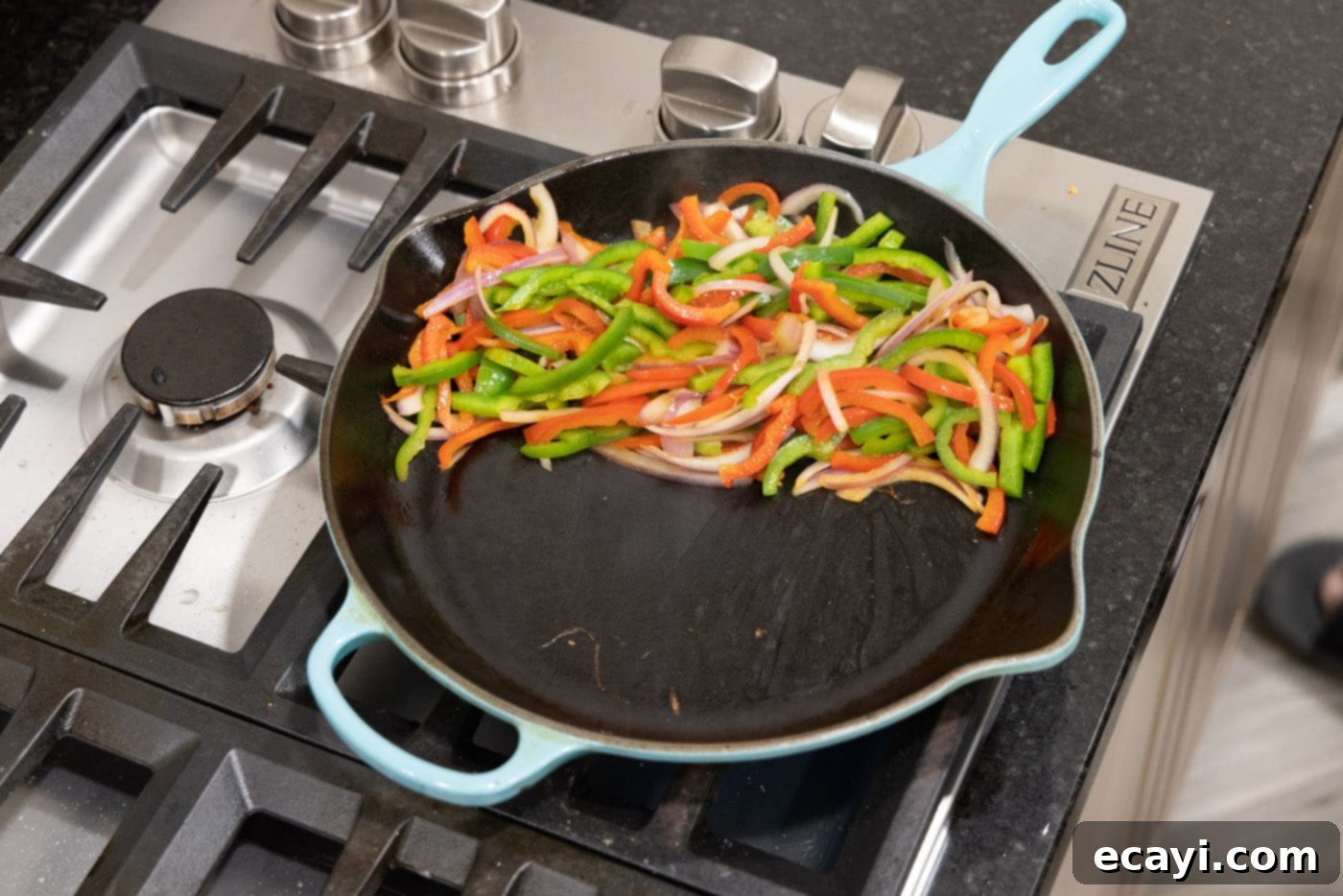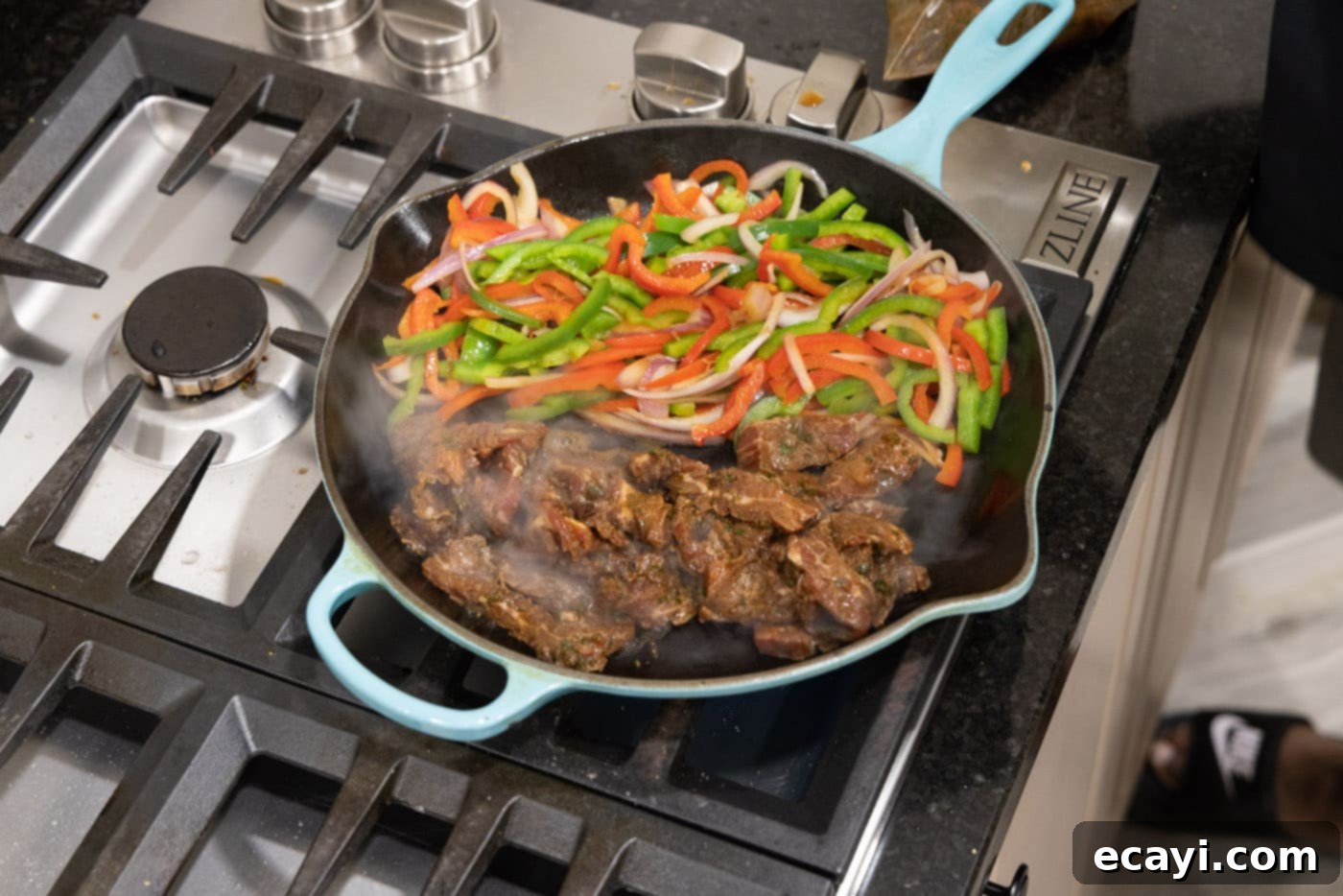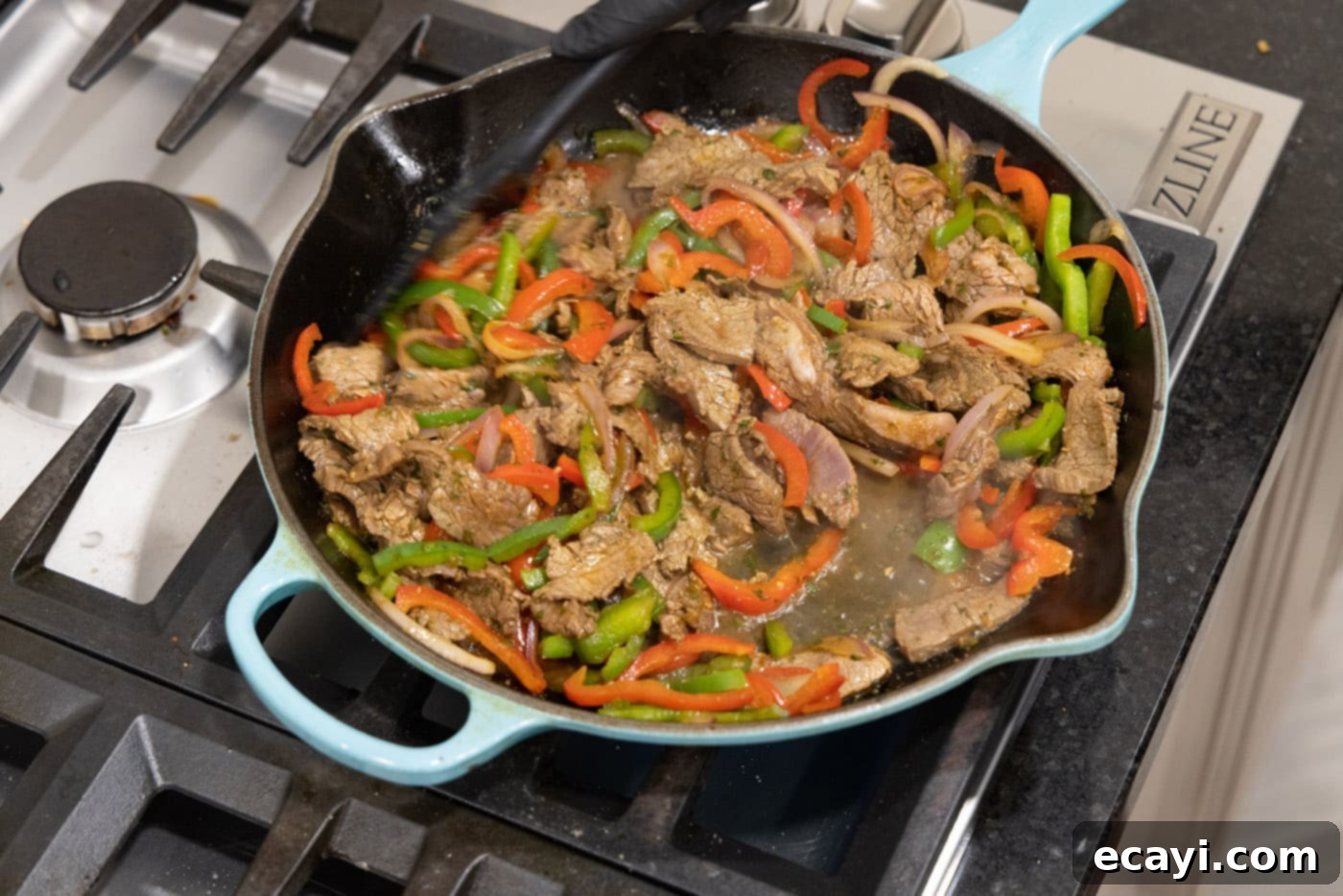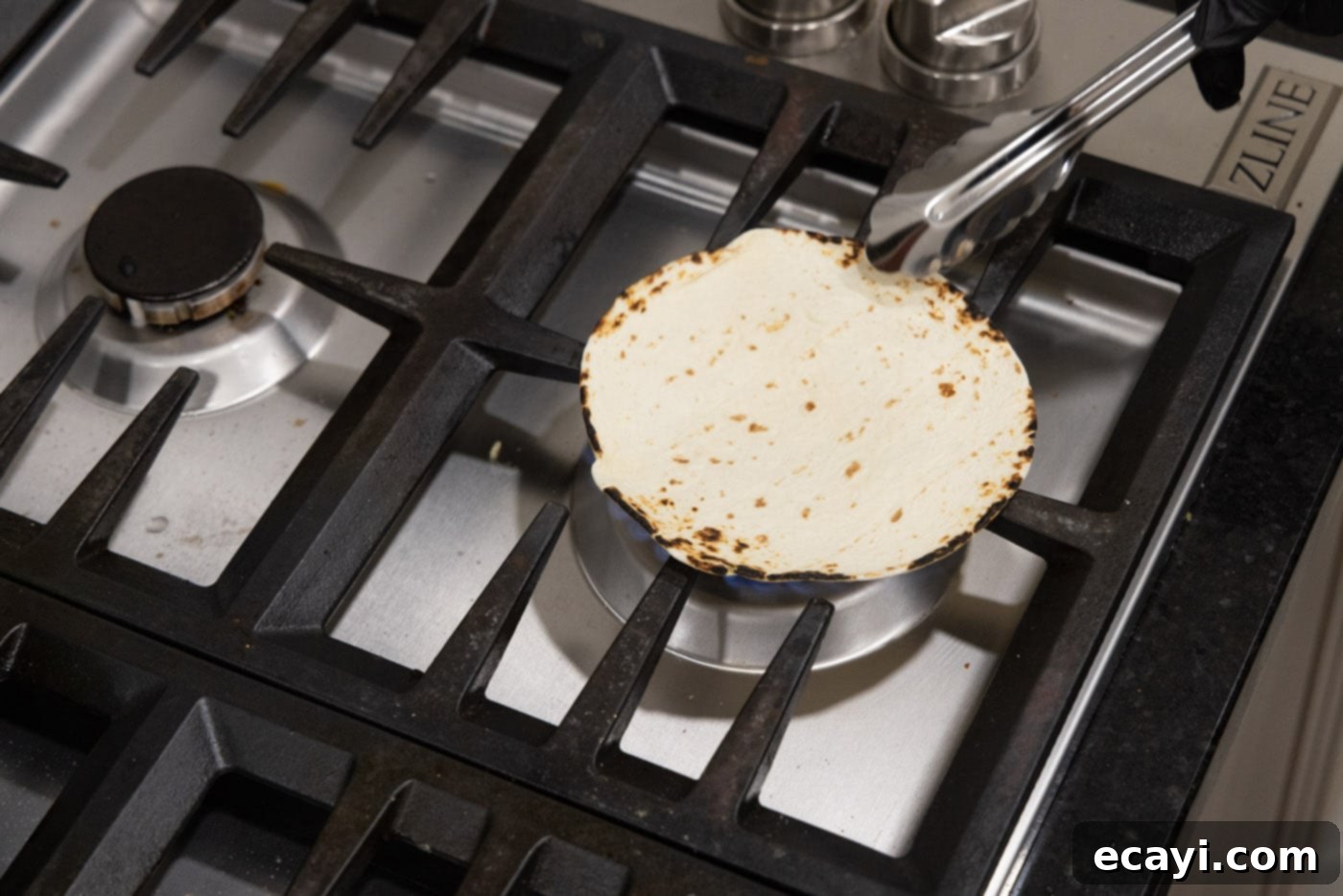Sizzling Steak Fajitas: Your Guide to Authentic Tex-Mex Flavor and Tender Perfection
Prepare for an unforgettable culinary experience with these sizzling steak fajitas! Bursting with authentic Tex-Mex flavor, this recipe features thinly sliced, juicy steak strips, marinated to perfection, then expertly tossed with tender-crisp red onions and vibrant bell peppers. Served hot off the skillet and wrapped in warm tortillas, these fajitas are guaranteed to transport your taste buds straight to a bustling taqueria.
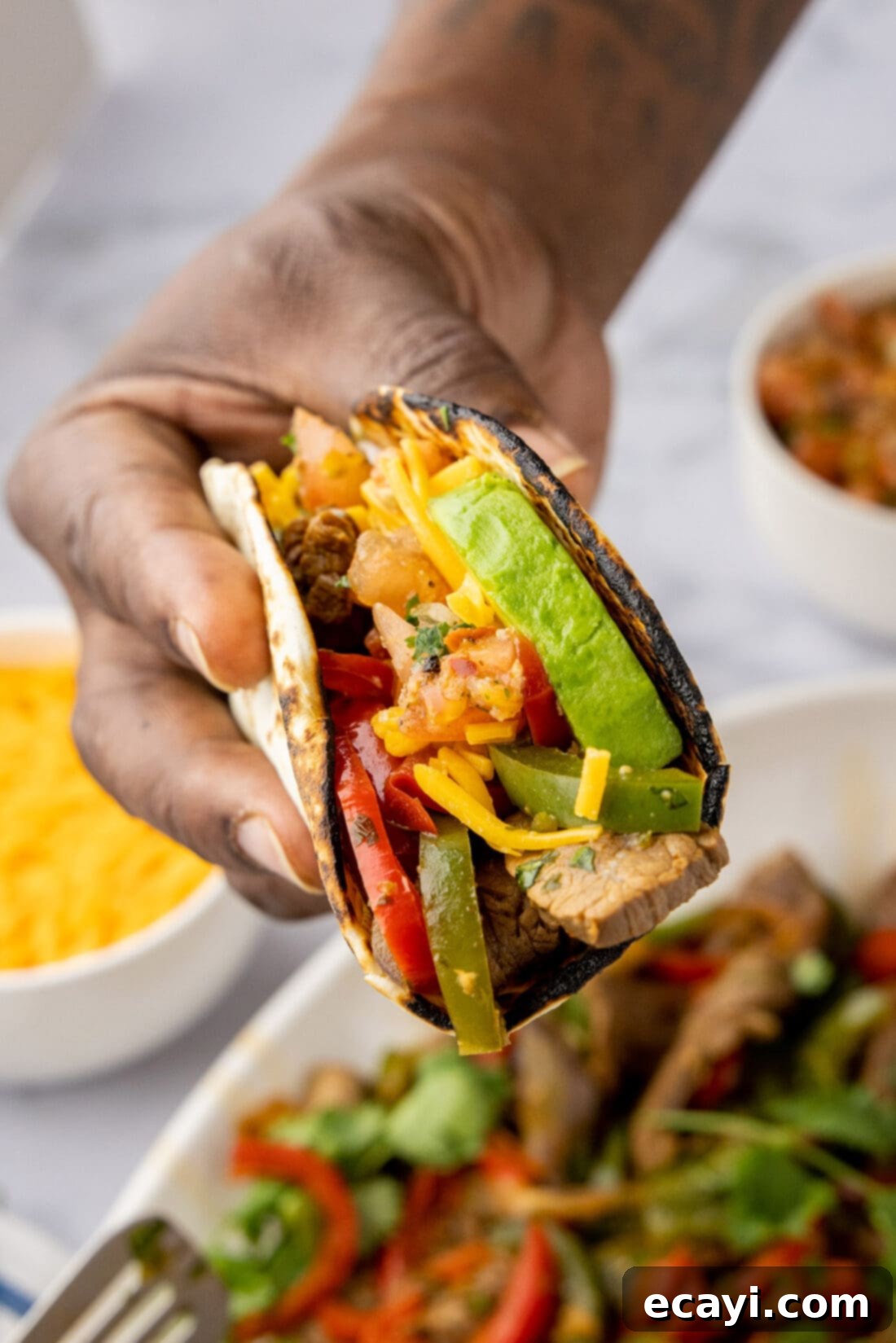
Why This Steak Fajita Recipe Delivers Unbeatable Flavor
Steak fajitas are a beloved Tex-Mex classic, renowned for their incredible flavor and interactive presentation. This recipe elevates the traditional fajita experience by focusing on key elements that guarantee a truly delicious meal. We start by submerging our thinly sliced steak in a robust, flavor-packed fajita marinade. This isn’t just about adding flavor; the marinade also plays a crucial role in tenderizing the beef, ensuring every bite is succulent and easy to chew. The magic continues as we swiftly sear vibrant bell peppers and red onions in a hot skillet, achieving that perfect tender-crisp texture that complements the steak so well. Finally, the marinated beef is added, quickly cooked to perfection, and combined with the aromatic vegetables, ready to be piled into warm corn or flour tortillas.
There’s something inherently captivating about fajitas, whether it’s chicken, shrimp, or steak. The moment they arrive at the table, sizzling dramatically in a cast iron skillet, they command attention. This recipe aims to replicate that show-stopping presentation and deliver a taste that lives up to the anticipation. The high-heat cooking method ensures a beautiful sear on both the steak and vegetables, locking in juices and creating a delightful caramelization that’s essential for authentic fajita flavor. By following our detailed steps, you’ll achieve perfectly seasoned, tender steak and vibrant, crisp vegetables, making this recipe a household favorite.
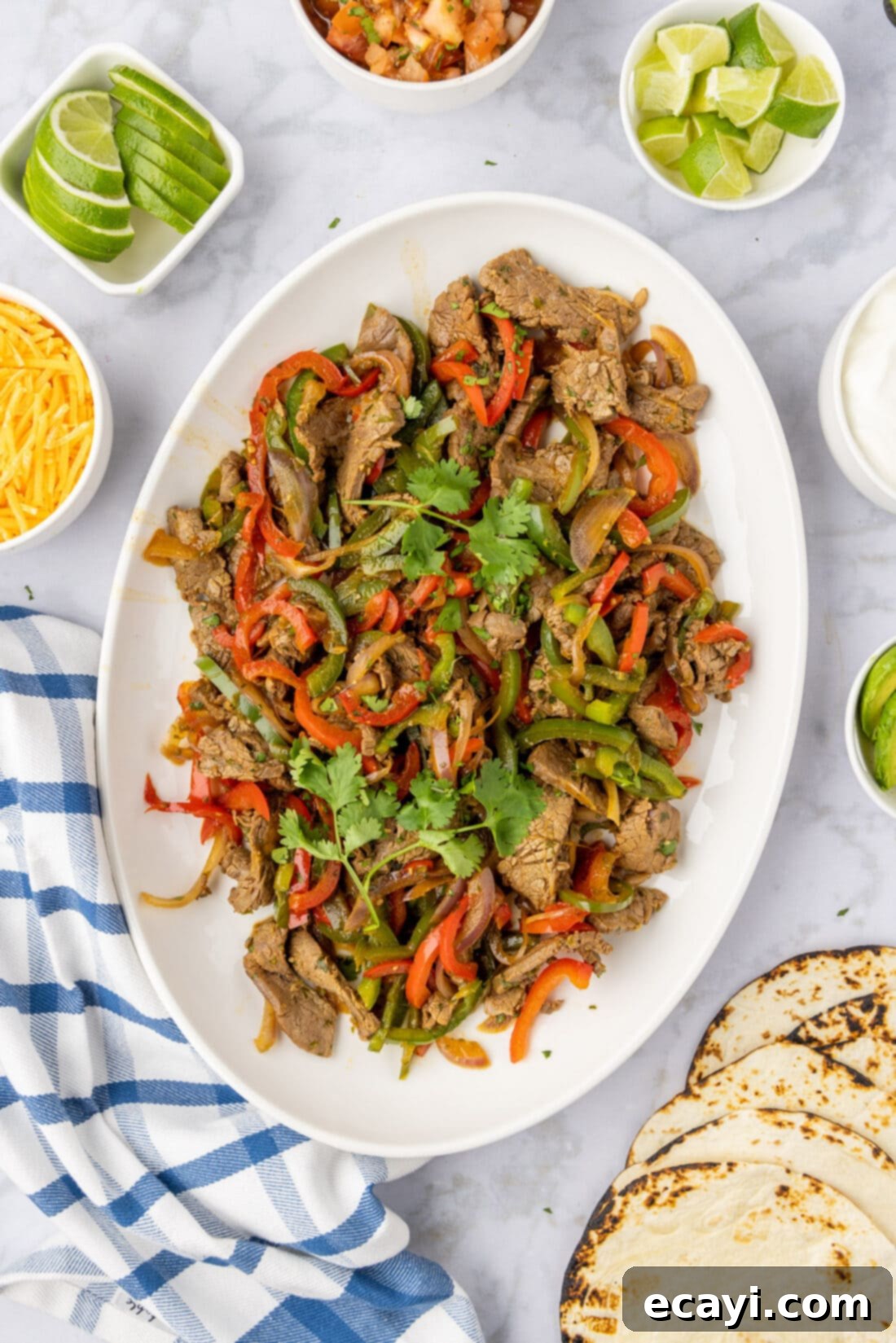
Essential Ingredients for Perfect Steak Fajitas
Crafting exceptional steak fajitas begins with selecting the right ingredients. Below is a general overview of what you’ll need. For precise measurements, a comprehensive list, and detailed instructions, please refer to the printable recipe card located at the end of this post.
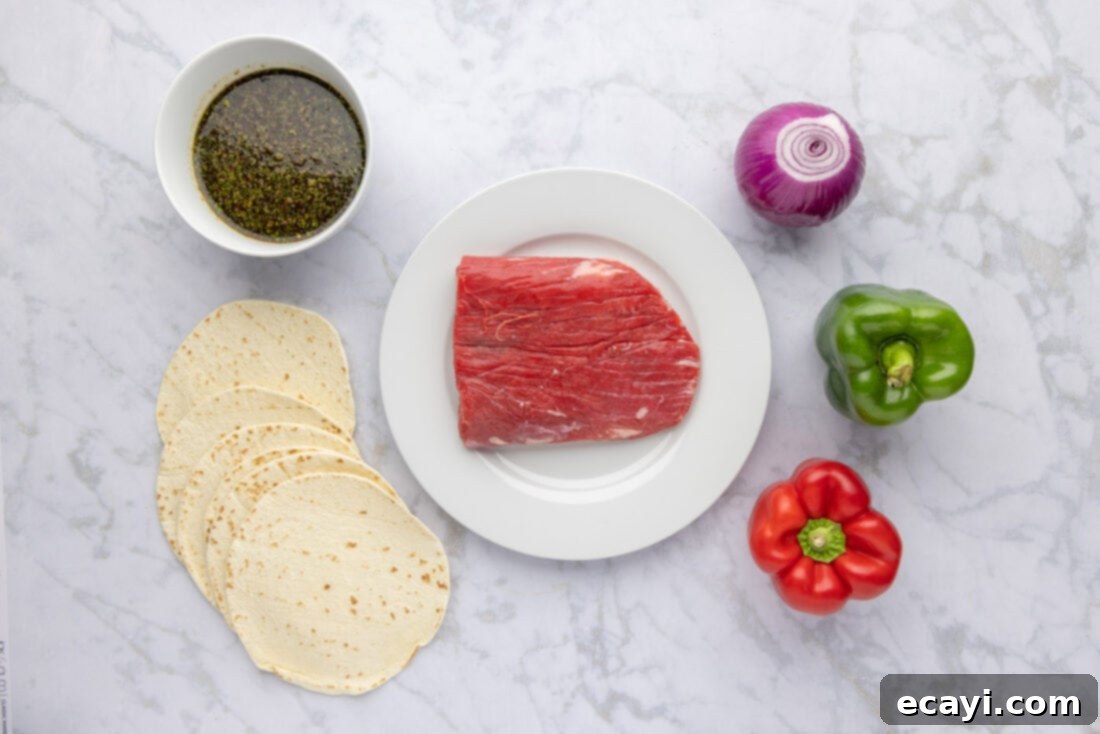
Ingredient Spotlight: Tips for Optimal Flavor and Texture
Understanding each ingredient’s role and potential substitutions can significantly enhance your cooking experience and the final dish. Here’s a deeper dive into the components of our delicious steak fajitas:
BEEF – Our preferred cut for this recipe is flank steak, known for its robust beefy flavor and relatively lean profile. When preparing flank steak, it is absolutely crucial to slice it thinly against the grain. This means cutting perpendicular to the long muscle fibers that run through the meat. By doing so, you effectively shorten these fibers, which tenderizes the meat and makes it much easier to chew once cooked. For those who enjoy a richer flavor, skirt steak is an excellent alternative. While skirt steak can be a bit tougher than flank, it boasts a more intense beefy taste. If using skirt steak, you might consider cooking it for slightly less time to prevent it from becoming overly fibrous. Both flank and skirt steak are ideal for fajitas because their lean nature allows them to readily absorb the flavors from the marinade, contributing to a deeply savory dish. Other cuts like sirloin or even strip steak can work, but flank and skirt are traditionally chosen for their texture and ability to soak up marinade.
MARINADE – The marinade is the heart and soul of these steak fajitas, transforming plain beef into a flavor powerhouse. Not only does it tenderize the meat, but it infuses every strip with a complex blend of aromatic and savory notes. Our homemade fajita marinade is crafted with a thoughtful combination of ingredients:
- Soy Sauce: Provides a deep umami base and helps to tenderize the meat through enzymatic action.
- Garlic & Cilantro: Classic aromatics that are fundamental to Mexican cuisine, adding freshness and pungency.
- Jalapeño: Delivers a gentle kick of heat, which you can adjust by removing the seeds for a milder flavor.
- Cumin & Paprika: Essential spices for that authentic Tex-Mex smoky, earthy flavor profile.
- Liquid Smoke: Adds a subtle, outdoor-grilled smokiness even if you’re cooking indoors.
- Garlic Powder: Reinforces the garlic flavor, ensuring it penetrates the meat thoroughly.
- Lime Juice: Crucial for its acidity, which not only brightens the flavors but also helps to further tenderize the beef.
This versatile marinade isn’t just for steak; feel free to use it on pork or chicken to create equally delicious fajitas or other marinated dishes.
BELL PEPPERS & ONION – We use a combination of red and green bell peppers for their vibrant color and slightly different flavor profiles. Red bell peppers are sweeter, while green bell peppers offer a more traditional, slightly bitter note. Red onion is preferred for its milder flavor when cooked and beautiful color. Slicing these vegetables into thin strips ensures they cook quickly and achieve that desired tender-crisp texture, adding a delightful crunch and sweetness to the fajitas. Feel free to experiment with other bell pepper colors (yellow or orange) or even add poblano peppers for an extra layer of mild heat and earthiness. Adding other vegetables like zucchini or mushrooms can also be a delicious variation.
OLIVE OIL – A good quality olive oil is essential for searing the vegetables and steak at high heat. Its high smoke point and flavor complement the fajita ingredients. You could also use avocado oil, which has an even higher smoke point, making it excellent for skillet cooking.
TORTILLAS – While corn tortillas are traditional and offer an authentic taste, flour tortillas are also a popular choice for their soft, pliable texture. Both can be heated directly over an open flame for a slightly charred, flexible finish, or simply warmed in a dry skillet or microwave. Taco-sized tortillas are ideal for individual servings.
Step-by-Step Guide: Crafting Your Perfect Steak Fajitas
These step-by-step photos and detailed instructions are provided to help you visualize each stage of making this incredible recipe. For a complete printable version of the recipe, including precise measurements and comprehensive instructions, please Jump to Recipe at the bottom of this page.
- Prepare and Marinate the Steak: Begin by thinly slicing your flank steak against the grain into uniform strips. This is key for tenderness. Place the sliced beef into a gallon-sized plastic bag, then pour in the homemade fajita marinade. Seal the bag, ensuring the meat is fully coated, and allow it to marinate at room temperature for a minimum of one hour. This marinating time is crucial for both tenderizing the beef and infusing it with maximum flavor.



- Slice Your Fajita Vegetables: While the steak is marinating, prepare your bell peppers and red onion by cutting them into thin, consistent strips. Uniformity in size ensures even cooking.

- Heat the Skillet: Place a cast iron skillet over medium-high heat. Add the olive oil and allow it to heat until it is shimmering. A hot skillet is essential for achieving a good sear on the vegetables and steak, preventing them from steaming.
- Cook the Vegetables: Add the bell pepper and onion strips to the hot skillet. Cook, stirring occasionally, for approximately 2-3 minutes, until they are tender-crisp. You want them cooked through but still retaining a slight bite and vibrant color.

- Sear the Steak: Once the vegetables reach the desired texture, push them to one side of the pan to create an empty space. Using tongs or a gloved hand, remove the beef strips from the marinade (we like our meat juicy, so we add it directly; if you prefer less pan juices, drain the marinated meat first and gently pat dry with paper towels). Add the beef to the empty side of the hot skillet. Cook, stirring occasionally, for 1-2 minutes until beautifully seared and cooked to your desired doneness. Discard any remaining marinade for food safety.

- Combine and Finish: Stir the cooked vegetables and beef together in the skillet, allowing them to meld their flavors for an additional 2-3 minutes. Turn off the heat and set the pan aside, keeping the fajita filling warm.


- Prepare the Tortillas: CAUTION: The next step involves an open flame. If you’re uncomfortable with this method, you can achieve warm and pliable tortillas by heating them in a dry skillet or wrapping them in damp paper towels and microwaving them briefly. However, heating tortillas directly over an open gas burner imparts a delicious, subtle char and makes them incredibly flexible.
- Toast each tortilla individually over an open flame on your stove. Use tongs to turn them frequently. Do not leave them unattended, as they will toast very quickly. Each side typically requires only about 5-10 seconds on the burner to become warmed and slightly charred. Stack the warmed tortillas in a tortilla warmer or wrap them in a clean kitchen towel to keep them soft and hot until serving.

Frequently Asked Questions & Expert Tips for Steak Fajitas
Flank steak is consistently among the most popular and recommended choices for beef fajitas. It offers a great balance of flavor and tenderness when sliced correctly. Skirt steak is another excellent option, prized for its even richer, beefier flavor. However, skirt steak is typically a bit tougher than flank, so you might want to cook it for a shorter duration to prevent it from becoming overly chewy. Both cuts are lean and exceptionally receptive to marinades, which effectively tenderize the meat and infuse it with layers of flavor. For a quick alternative, sirloin or even tenderloin can be used, but flank and skirt steak are truly the stars for authentic fajita texture and taste.
To maintain the best texture and prevent sogginess, it’s crucial to store the cooked beef and vegetable filling separately from the tortillas. Place the cooled fajita filling in an airtight container and keep it in the refrigerator for up to 3-4 days. Store any leftover tortillas separately in their original packaging or a sealed bag at room temperature.
For reheating the beef and vegetables, the best method is to warm them gently in a skillet over medium to low heat on the stovetop. This typically takes only a few minutes until thoroughly warmed through. Alternatively, you can spread the filling on a baking sheet and reheat it in a 250°F (120°C) oven for about 10 minutes. The key is to avoid high temperatures and prolonged cooking, as this can easily overcook the beef, leading to a tough and chewy texture. For tortillas, a quick reheat in a dry skillet or microwave works best.
Yes, the cooked steak and vegetable filling freezes beautifully! Allow the filling to cool completely, then transfer it to a sealed freezer bag or an airtight freezer-safe container. It can be stored in the freezer for up to 3 months. When you’re ready to enjoy them, thaw the filling overnight in the refrigerator, then reheat on the stovetop as described above. Remember to always freeze the filling separately from the tortillas.
The hallmark of great fajitas is that incredible sizzle! To achieve this, ensure your cast iron skillet is scorching hot before adding any ingredients. Don’t overcrowd the pan, as this lowers the temperature and can lead to steaming rather than searing. Cook the vegetables and steak in batches if necessary, to maintain that high heat and create those delicious caramelized edges.
Our marinade includes jalapeño for a mild kick, but you can easily adjust the heat to your preference. For less heat, remove the seeds and white membrane from the jalapeño before adding it to the marinade. For more heat, you can include the seeds, or even add a pinch of cayenne pepper or a dash of your favorite hot sauce to the marinade or while cooking the steak.
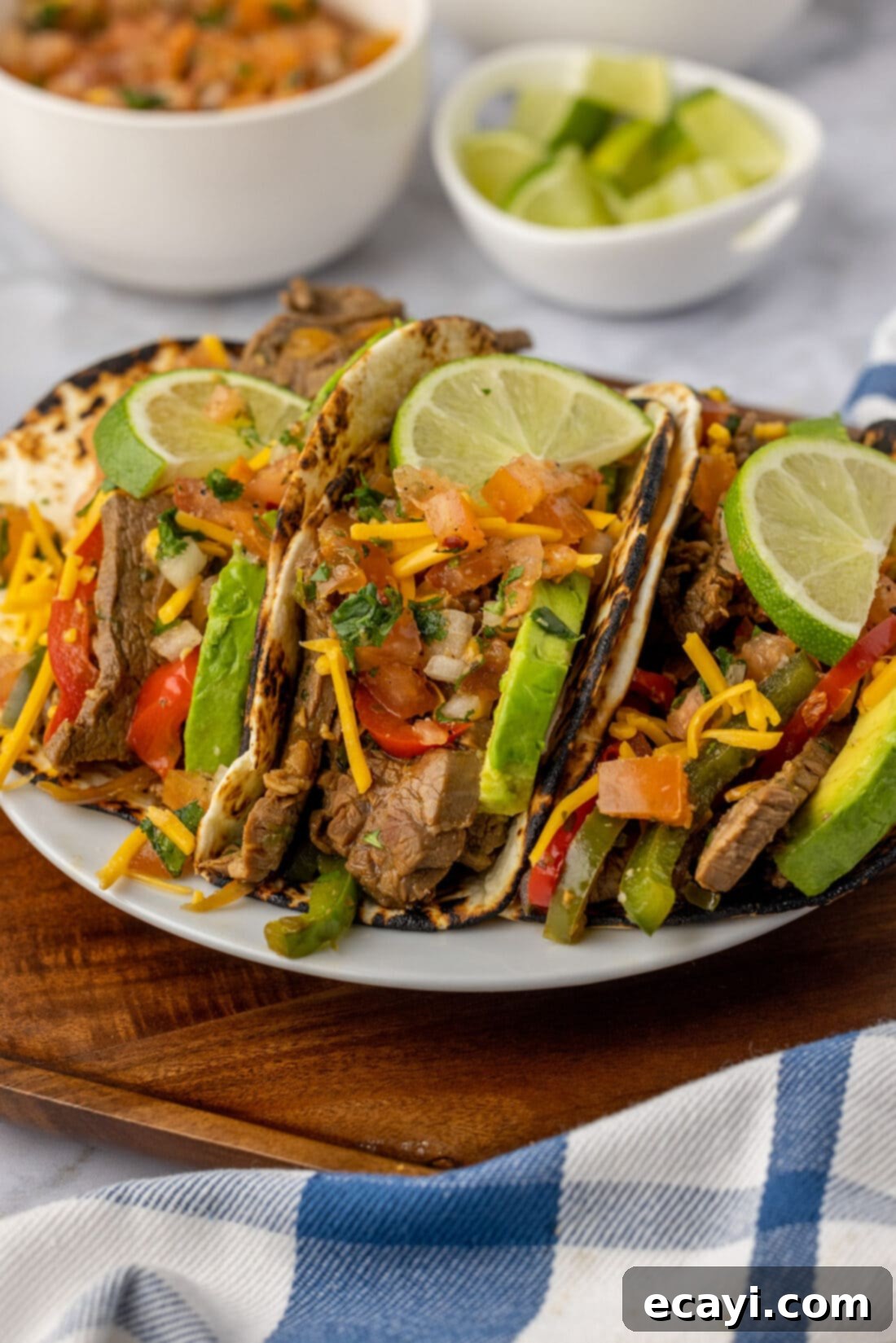
Creative Ways to Serve Your Steak Fajitas
Steak fajitas are incredibly versatile and can be customized with a wide array of toppings and sides to suit any taste. Here are some fantastic serving suggestions to make your fajita night truly special:
- Classic Toppings: A generous dollop of cool sour cream or a lighter Greek yogurt, fresh salsa fresca (pico de gallo), zesty salsa verde, shredded Monterey Jack or cheddar cheese, creamy guacamole, or simply sliced avocados with plenty of fresh lime wedges to squeeze over everything.
- Hearty Sides: Complete your meal with classic Mexican sides such as fluffy Spanish rice, savory refried beans, or wholesome black beans. For a lighter touch, a simple corn salad or Mexican street corn (Elote) makes a great accompaniment.
- Low-Carb Options: If you’re looking to reduce carbs, skip the tortillas entirely! Instead, wrap the flavorful sliced beef and veggies into crisp lettuce leaves for a refreshing fajita wrap, or transform it into a vibrant “fajita bowl” by serving the filling over a bed of cauliflower rice or mixed greens.
- Extra Zest: Don’t forget the power of fresh lime! A squeeze of lime juice over the cooked fajita filling adds a bright, essential acidity that truly brings all the flavors to life.
More Delicious Tex-Mex and Steak Recipes to Explore
If you loved these steak fajitas, we encourage you to explore more of our related recipes that bring the vibrant flavors of Mexican and Tex-Mex cuisine right to your kitchen:
- Carne Asada: Perfectly grilled marinated steak, fantastic for tacos or standalone.
- Shrimp Fajitas: A lighter seafood alternative to the classic steak.
- Chimichangas: Deep-fried burritos, a crispy and satisfying meal.
- Chicken Fajita Salad: All the flavor of fajitas, served as a fresh and hearty salad.
- Chicken Fajitas: A popular poultry version, equally flavorful and easy to make.
I love to bake and cook and share my kitchen experience with all of you! Remembering to come back each day can be tough, that’s why I offer a convenient newsletter every time a new recipe posts. Simply subscribe and start receiving your free daily recipes!

Steak Fajitas
IMPORTANT – There are often Frequently Asked Questions within the blog post that you may find helpful. Simply scroll back up to read them!
Print It
Pin It
Rate It
Save ItSaved!
Ingredients
- 1 pound flank steak
- 1 ½ cups homemade fajita marinade
- 1 large red bell pepper cut into strips
- 1 large green bell pepper cut into strips
- ½ large red onion cut into strips
- 2 Tablespoons olive oil
- 6 corn tortillas or flour, taco size
Things You’ll Need
-
Large cast iron skillet
-
Vinyl gloves
Before You Begin
- Always cut flank steak thinly against the grain. This technique shortens the muscle fibers, significantly tenderizing the meat and making it easier and more pleasant to chew.
- Flank steak and skirt steak are prime choices for fajitas. Skirt steak is slightly tougher but boasts a more intense beef flavor; if using, consider reducing cook time to prevent excessive fibrousness. Both cuts benefit immensely from marinades.
- To prevent soggy tortillas, store leftover beef and veggies separately in an airtight container in the refrigerator for up to 3-4 days.
- Reheat the fajita filling in a skillet over medium-low heat for a few minutes, or in a 250°F oven for about 10 minutes. Avoid high heat to prevent overcooking and toughening the beef.
- The fajita filling (beef and veggies) can be frozen for up to 3 months. Ensure it’s cooled completely before placing in a sealed freezer bag or airtight container. Thaw overnight in the refrigerator before reheating on the stovetop.
Instructions
-
Cut flank steak against the grain into thin strips. Place meat into a gallon sized plastic bag and pour in the marinade. Seal the bag and allow to marinate at room temperature for one hour.
-
Cut bell peppers and onion into thin strips.
-
Heat olive oil in a cast iron skillet over medium-high heat until shimmering.
-
Add bell pepper and onion strips and cook, stirring occasionally, until tender crisp, about 2-3 minutes.
-
Move all the vegetables to one side of the pan. Using tongs or your gloved hand, remove beef from marinade and add it to the empty side of the pan. Cook, stirring occasionally for 1-2 minutes. Discard leftover marinade.
TIP – We like our meat to be juicy, so we add the meat to the pan right out of the marinade. If you prefer less pan juices, drain the marinated meat first and gently pat dry with paper towels.
-
Stir vegetables and beef together, cooking for an additional 2-3 minutes. Turn off heat and set pan aside.
-
CAUTION: the next step requires an open flame. If you prefer, you can also heat the tortillas in a dry skillet but the flame gives you those nice char marks.
Toast tortillas over open flame on your stove, turning with tongs. Do not leave the tortillas alone and they will need to be turned fairly quickly.
-
Each side only needs about 5-10 seconds on the burner.
Nutrition
The recipes on this blog are tested with a conventional gas oven and gas stovetop. It’s important to note that some ovens, especially as they age, can cook and bake inconsistently. Using an inexpensive oven thermometer can assure you that your oven is truly heating to the proper temperature. If you use a toaster oven or countertop oven, please keep in mind that they may not distribute heat the same as a conventional full sized oven and you may need to adjust your cooking/baking times. In the case of recipes made with a pressure cooker, air fryer, slow cooker, or other appliance, a link to the appliances we use is listed within each respective recipe. For baking recipes where measurements are given by weight, please note that results may not be the same if cups are used instead, and we can’t guarantee success with that method.
